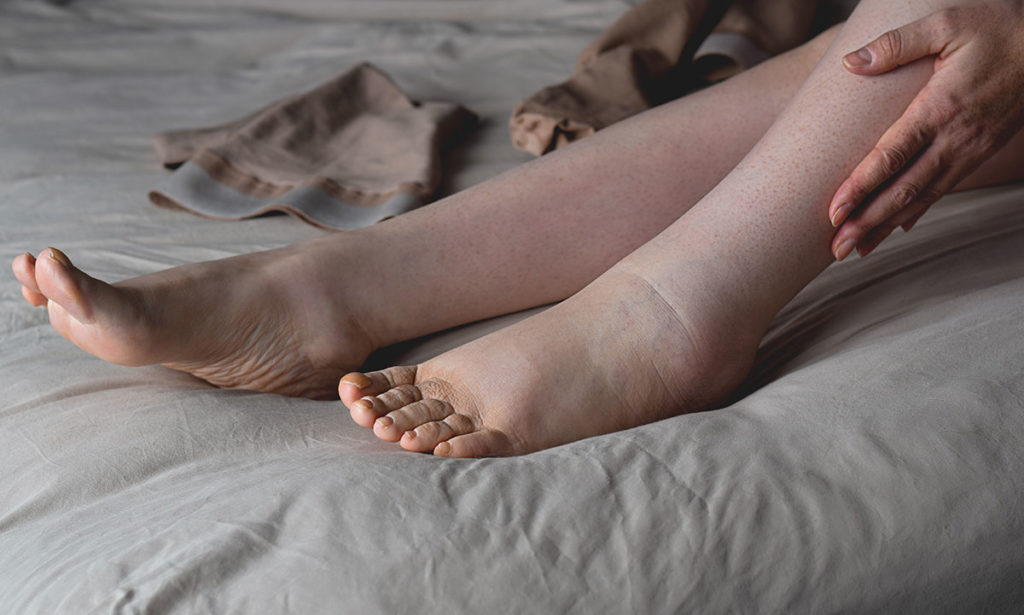
Lymphedema is the swelling of the arms, legs, chest, or trunk, caused by a blockage in the lymphatic system. The lymphatic system is an important part of both the immune and circulatory systems. Lymph vessels run very close to blood vessels and move fluid from the body through the lymph nodes, then into the blood. The lymph nodes work as filters to fight infection and help regulate swelling. The blockage prevents lymph fluid from draining, and as the fluids build up, swelling continues. With lymphedema, joint movement is restricted and painful, and the skin over the affected area becomes taut and dry. It is most commonly caused by the removal of, or damage to, lymph nodes during cancer treatment. The most effective lymphedema treatment is complete decongestive therapy (CDT), sometimes called complex decongestive therapy. CDT is an intensive two-phase program that combines various treatment approaches. CDT is considered the gold standard treatment for lymphedema that has progressed beyond stage 1, meaning there is swelling without pitting.
Phase I
CDT’s Phase I objective is to remove and reduce visible swelling, as well as other lymphedema symptoms. Treatment plans are created for each individual patient, but Phase I typically includes meeting with the lymphedema therapist daily for anywhere from 2 to 5 weeks, depending on how long it takes to bring down swelling and improve other symptoms affecting the skin. Lymphedema therapists use measurements and visual examinations of the arm, hand, chest, or trunk to decide when phase I sessions are complete.
Manual Lymphatic Drainage
The first step is manual lymphatic drainage (MLD). MLD uses light touch to move excess lymph and fluid out of a person’s tissues and back into the lymphatic vessels. It is often compared to a massage, but MLD is extremely different from traditional massages that rely on deep and rigorous kneading. MLD is much gentler, and should feel as though the skin is being brushed, not rubbed. Each session of manual lymphatic drainage typically takes about 20-45 minutes.
Compression Bandaging
The next step of Phase I is short-stretch compression bandaging. The process begins with an inner liner made of stocking-like gauze, also known as a stockinette, placed on the affected area after moisturizing with a gentle lotion. In most cases, padding is placed over the stockinette, followed by multiple overlapping layers of short-stretch bandages, which are similar to Ace bandages. The bandages will feel snug, not tight. Bandaging is a reductive therapy that helps prevent fluid from flowing back into the limb and softens tissue under the skin, which is why bandaging is very important to lymphedema treatment. Bandages in this phase are typically worn at all times, and are only removed for showering, bathing, or MLD sessions.
Exercise
Exercise is a very important part of lymphedema treatment. Exercise, combined with compression, helps the body’s natural muscle pump to increase venous and lymphatic fluid return to the circulatory system, and out of the swollen areas. Because every person is different, exercise treatments for lymphedema is catered toward the patient’s specific needs. Lymphedema exercises, also known as remedial exercises, are rhythmic muscle and breathing exercises used as a part of Phase I treatment. In Phase II, these exercises are combined with or integrated into a regular exercise program. Some forms of exercise for lymphedema treatment are flexibility or stretching exercises, resistance or weight lifting exercises, and aerobic conditioning or cardiopulmonary exercises.
Phase II
Phase II of lymphedema treatment is about the patient maintaining the results of Phase I on his own. Depending on your specific treatment plan, patients can expect to continue Phase II of CDT for many years. In this phase, the patient is fitted for compression sleeves and garments. Compression sleeves are designed to apply pressure to the arm, hand, or trunk to keep lymph moving in the right direction. Examples of compression garments include sleeves worn on the arm, a fingerless glove or gauntlet, a support bra for the chest, or vest for the trunk area. Compression garments are made of flexible fabric, and are tighter at the top than the bottom of the sleeve to create gradient pressure that keeps the lymph moving. Lymphedema therapists determine how long, and how often, the compression sleeves or garments must be worn to maintain results.
Treatment varies for each patient because certain treatments are more effective on some than others. Your lymphedema therapist can work with you, over time, to ensure your lymphedema is under control and recommend treatments as necessary. If you have any questions about Lymphedema or want to learn more about Lymphedema Therapy, call us at 1-800-849-0203 to schedule an appointment with our Lymphedema Therapist.
Sources:

